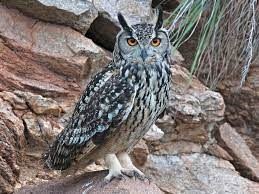Prelims 07-03-2024
Topic 1: Indian Eagle Owl

- The Indian eagle-owl had been classified as a species only in recent years, thus distinguishing it from the Eurasian eagle-owl. It was observed that the Indian species is an imposing bird. It was further noted that the slightly larger female could reach a total length of two and a half feet, with a wingspan of six feet.
- Due to its nocturnal habits, very little is known about the Indian eagle-owl. The widespread range, encompassing the entire Indian peninsula, suggests a stable population, although its actual status remains uncertain due to its uncommon occurrence.
- Their total numbers have never been estimated. While many bird, species are experiencing decline due to the reduction in total forested area in the country, the Indian eagle-owl does not rely on forests. It prefers hunting over open scrubland and agricultural tracts, where rats, bandicoots, and even bats and doves are regular prey. Nearby rocky perches and crags are ideal nesting sites for the Indian eagle-owl.
What’s the myth surrounding the Indian Eagle Owl?
- Near human settlements, mango trees are preferred by the Indian eagle-owl. In rural India, numerous superstitions surround this bird and its loud double-hoot calls, often considering them bearers of ill omens.
- The noted ornithologist Salim Ali documented folklore suggesting that an eagle-owl, when trapped and starved, would speak in a human voice and predict the future of its listeners. However, they are also associated with wisdom. The Uluka, symbolizing knowledge and prosperity, is attributed to the Goddess Lakshmi.
How do they benefit agriculture?
- The presence of Indian eagle-owls is beneficial to farmers. Research conducted by the Ela Foundation and the Zoological Survey of India indicates that Indian eagle-owls nesting near agricultural lands produce more and healthier owlets compared to those nesting in scrublands. The owls near agricultural lands benefit from the abundant populations of rodents found in and around farms.
Topic 2: Red Sanders
Why in News?
- Geographical Indication tag has been sought for Andhra Pradesh Red Sanders.
What is Red Sanders?
- It is an Indian endemic tree species, with a restricted geographical range in the Eastern Ghats of India. It is endemic to a distinct tract of forests in Andhra Pradesh.
- Its IUCN status is endangered.

- It is also known as: Saunderwood, Red Sanders, Red Sanderswood, Red Saunders, Rakta chandana (Indian), Lal Chandan, Ragat Chandan, Rukhto Chandan.
- It is a deciduous tree which grows to 5-8m in height and has a dark grayish bark. The inner bark, when injured and cut, oozes red coloured santolin dye. It is disturbed in peninsular India and Sri Lanka. It occurs in patches in tropical dry deciduous forests, towards South-Eastern ghats.
Why there is huge demand for it in international market?
- There is a huge demand for this timber in the domestic and international market, especially in East Asian Countries. Red Sanders timber is used for carvings. furniture, poles, and house posts. The rare “wavy” grain variant is highly valued in Japan for its acoustic properties and is used to make musical instruments.
- In addition, the timber is also exploited for the extraction of Santalin (a red pigment used as dye and colorant in food), medicine and cosmetics.
What are the government policy to regulate its export and illegal trading?
- In 2019, the Directorate General of Foreign Trade, an agency of the Ministry of Commerce and Industry permitted the export of red sander timber, if it is obtained from cultivated land.
- Recently, this export policy is amended which allows an annual export quota for artificially propagated red sanders and zero export quota for wild specimens of red sander.
